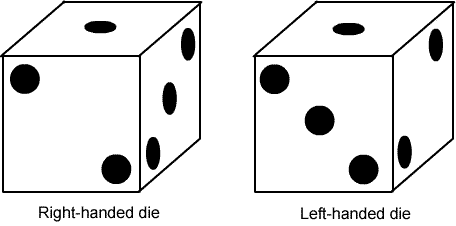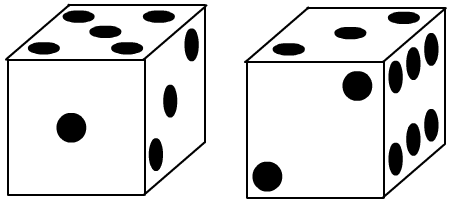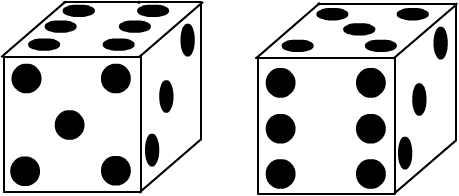Right or left?
Problem
You may know that opposite faces of a dice add up to $7$, but did you know that there are two different types of dice?
Here are two dice, a right-handed one and a left-handed one:

Decide whether the dice below are right-handed or left-handed:

Now try these - they are more difficult.

This problem is taken from the book "Mathematical Activities from Poland" published by ATM.
Getting Started
If you are having trouble with the visualisation and you don't have left-handed and right-handed dice, you could stick spots onto cubes to help.
Alternatively, print off this sheet which has a net of a right-hand dice on the first page and a net of a left-handed dice on the second.
Student Solutions
Many of you sent in correct answers to this problem, but not all were as well explained as these. Wilson from Beecroft Primary School wrote to say:
To work out the whether the dice are right- or left-handed, I pictured the dice in my head and then I matched them up with the pictures.
Philip from Woodfall Junior School also took this approach and says:
You can mentally rotate each die (finding the missing numbers by using the knowledge that opposite faces add up to seven) so that this happens, and then you can see if the die is right-handed, with the two at the front, or left-handed, with the three at the front.
April from Springfield Junior School explains exactly what she visualised:
1. Right-handed die
Roll it backwards so the $5$ is at the back and the $1$ is on the
top. The front face will be $2$ because $5+2=7$. $3$ will still be
on the right.
2. Right-handed die
Roll it to the right so the $6$ is on the bottom. That means $1$ is
on the top because $6+1=7$. $3$ is on the right and $2$ stays at
the front.
3. Right-handed die
Roll it backwards $2$ times so the $5$ is at the back and the 6 is
on the bottom. The top is $1$ because $6+1=7$, and the front is $2$
because $5+2=7$. $3$ stays on the right.
4. Left-handed die
Roll it forwards so the $6$ is on the bottom. The top is $1$
because $6+1=7$. The $5$ moves from the top to the front. Turn it
left so the five moves to the left hand side and the $3$ moves to
the front. The right hand side is $2$ because $5+2=7$.
This is a great step-by-step way of approaching the problem, April. Well done.
